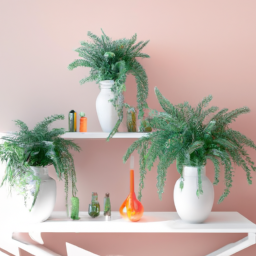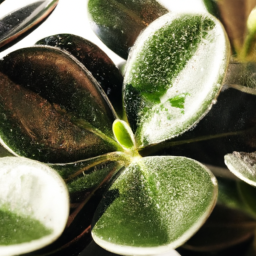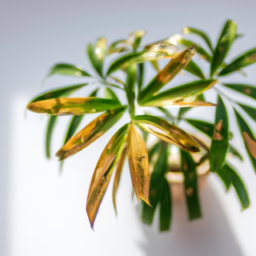
Have you ever noticed your indoor plants starting to turn yellow? It can be concerning to see your once vibrant green plants losing their color. There are a few common reasons why this may be happening, and in this blog post, we’ll explore some of the most common causes of why indoor plants turn yellow. So, if you’re wondering “When Indoor Plants Turn Yellow,” keep reading to learn more about how to diagnose and treat this issue.
Common Causes of Indoor Plants Turning Yellow
1. Lack of sunlight
When indoor plants start turning yellow, one of the most common causes is a lack of sunlight. Plants need sunlight to photosynthesize and produce food, so when they don’t get enough light, they can’t make the energy they need to thrive. If your plants are in a dark corner or far from a window, consider moving them to a brighter spot. You can also supplement with artificial grow lights to ensure they get the light they need.
In addition to the quantity of light, the quality of light is also important. Different plants have different light requirements, so make sure you know what your specific plants need. Some plants prefer direct sunlight, while others do better in indirect light. Pay attention to how your plants are responding to the light they’re getting and adjust as needed.
Another factor to consider is the duration of light exposure. Plants need a certain number of hours of light each day to thrive. If your plants are not getting enough hours of light, they may start to turn yellow. Be sure to research the light requirements of your specific plants and make sure they are getting the right amount of light each day.
2. Overwatering
Overwatering is another common cause of indoor plants turning yellow. When plants are overwatered, their roots can become waterlogged and suffocate, leading to yellowing leaves. To prevent overwatering, make sure your plants are in well-draining pots and that you are allowing the soil to dry out between waterings.
Signs of overwatering include wilting leaves, yellowing leaves, and root rot. If you suspect your plants are being overwatered, check the soil moisture level by sticking your finger into the soil. If it feels wet, wait to water until the top inch or two of soil is dry. You can also use a moisture meter to help you determine when to water your plants.
In addition to adjusting your watering schedule, you can also improve drainage by adding perlite or sand to your potting mix. This will help excess water drain away from the roots and prevent waterlogged soil. Proper watering is key to keeping your indoor plants healthy and green.
3. Nutrient deficiencies
Another common cause of indoor plants turning yellow is nutrient deficiencies. Plants need a variety of nutrients to thrive, including nitrogen, phosphorus, potassium, and micronutrients like iron and magnesium. If your plants are not getting the nutrients they need, they may start to show signs of yellowing leaves.
To prevent nutrient deficiencies, make sure you are using a high-quality potting mix that is enriched with nutrients. You can also fertilize your plants regularly with a balanced fertilizer to ensure they are getting all the nutrients they need. Be sure to follow the instructions on the fertilizer package to avoid over-fertilizing, which can also cause yellowing leaves.
If you suspect your plants have a nutrient deficiency, you can use a liquid fertilizer to give them a quick boost. Look for a fertilizer that is specifically formulated for indoor plants and follow the instructions on the package. With proper nutrition, your indoor plants will stay healthy and vibrant.
In conclusion, there are several common causes of indoor plants turning yellow, including lack of sunlight, overwatering, and nutrient deficiencies. By understanding these factors and taking steps to address them, you can help your plants stay healthy and green. Pay attention to the light, water, and nutrients your plants are getting, and make adjustments as needed to keep them thriving. With proper care, your indoor plants will continue to brighten up your space for years to come.
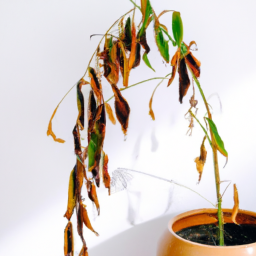
When Indoor Plants Turn Yellow
Introduction
Indoor plants can bring life and beauty to any space, but it can be disheartening when they start to turn yellow. There are several reasons why indoor plants may turn yellow, and it’s important to identify the cause in order to take the appropriate action. In this guide, we will explore the common reasons why indoor plants turn yellow and provide tips on how to prevent this from happening.
Common Reasons for Indoor Plants Turning Yellow
1. Overwatering
One of the most common reasons why indoor plants turn yellow is overwatering. When plants receive too much water, their roots can become waterlogged, leading to a lack of oxygen and root rot. This can cause the leaves to turn yellow and eventually die. To prevent overwatering, make sure to allow the soil to dry out between waterings and always check the moisture level before watering again.
Additionally, ensure that your plant is in a pot with proper drainage holes to allow excess water to escape. It’s also important to use a well-draining potting mix to prevent water from accumulating at the bottom of the pot.
If you suspect that your plant is suffering from overwatering, stop watering immediately and allow the soil to dry out. You may need to repot the plant in fresh, well-draining soil to help it recover.
2. Lack of Light
Another common reason for indoor plants turning yellow is a lack of light. Plants need sunlight to photosynthesize and produce energy, so insufficient light can cause them to become weak and pale. If your plant is not receiving enough light, its leaves may start to turn yellow as a result.
To prevent this from happening, make sure to place your indoor plants in a location where they can receive adequate sunlight. Different plants have different light requirements, so it’s important to research the specific needs of your plant and place it accordingly. If natural light is limited, you can also supplement with artificial grow lights to ensure your plants receive the light they need.
Regularly rotate your plants to ensure all sides receive equal light exposure, and keep an eye out for signs of sunburn, such as brown spots on the leaves. Adjust the placement of your plants as needed to prevent damage from too much direct sunlight.
3. Nutrient Deficiency
Indoor plants require a balance of nutrients to thrive, and a deficiency in essential nutrients can cause them to turn yellow. Common nutrient deficiencies that can lead to yellowing leaves include nitrogen, iron, and magnesium. If your plant is not receiving enough nutrients, its growth may be stunted, and its leaves may start to yellow.
To prevent nutrient deficiencies, make sure to fertilize your indoor plants regularly with a balanced fertilizer that contains all the necessary nutrients. Follow the instructions on the fertilizer package and avoid over-fertilizing, as this can also lead to yellowing leaves.
If you suspect that your plant is suffering from a nutrient deficiency, you can try supplementing with a targeted fertilizer to address the specific issue. It’s also a good idea to periodically check the pH level of the soil, as imbalances can affect nutrient uptake and lead to yellowing leaves.
Conclusion
Indoor plants can turn yellow for a variety of reasons, including overwatering, lack of light, and nutrient deficiencies. By identifying the cause of yellowing leaves and taking the appropriate action, you can help your indoor plants thrive and remain healthy. Remember to monitor your plants regularly, provide them with the care they need, and enjoy the beauty they bring to your home.
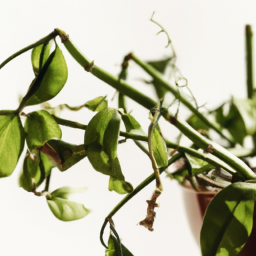
Tips for Reviving Yellowing Indoor Plants
Identifying the Problem
When your indoor plants start turning yellow, it can be a sign of various issues that need to be addressed. One common cause of yellowing leaves is overwatering. When plants receive too much water, their roots can become waterlogged, leading to a lack of oxygen and nutrient uptake. This can result in yellowing leaves and eventual plant death. Another common issue is nutrient deficiency, particularly a lack of nitrogen, which is essential for healthy leaf growth. Additionally, yellowing leaves can be a sign of pests or diseases, such as spider mites or fungal infections.
To identify the specific problem causing your indoor plants to turn yellow, start by examining the leaves closely. Look for any signs of pests, such as tiny insects or webbing, as well as any unusual spots or discoloration. Check the soil moisture level by sticking your finger into the soil – if it feels wet or soggy, your plant may be overwatered. Consider the plant’s location and light exposure, as inadequate light can also cause leaves to yellow. By carefully observing your plant and its environment, you can better determine the underlying issue and take appropriate action.
Once you have identified the problem causing your indoor plants to turn yellow, it’s important to take immediate steps to address it. For overwatered plants, allow the soil to dry out before watering again, and consider repotting into a well-draining potting mix. If your plant is suffering from nutrient deficiency, consider fertilizing with a balanced fertilizer or a specific nutrient blend for the particular deficiency. For pests or diseases, remove affected leaves or treat with a suitable insecticide or fungicide. Adjusting the plant’s location to provide more light or better air circulation can also help promote healthy growth and prevent further yellowing.
Reviving Yellowing Plants
Reviving yellowing indoor plants can be a challenging but rewarding process. Once you have identified the underlying issue causing your plant to turn yellow, it’s important to take prompt action to address it and help your plant recover. One key step in reviving yellowing plants is to adjust your watering routine to prevent overwatering or underwatering. Allow the soil to dry out slightly between waterings, and water thoroughly but avoid letting the plant sit in standing water, which can lead to root rot.
In addition to adjusting your watering routine, consider repotting your plant into fresh, well-draining soil to improve root health and nutrient uptake. Trim away any yellow or damaged leaves to encourage new growth, and fertilize your plant with a balanced fertilizer to provide essential nutrients for healthy leaf development. Monitor your plant closely for signs of improvement, such as new growth or greening leaves, and continue to provide proper care to help your plant recover fully.
When reviving yellowing indoor plants, it’s important to be patient and consistent in your care routine. Monitor your plant regularly for any signs of improvement or worsening symptoms, and adjust your care practices as needed. With proper attention and care, most indoor plants can recover from yellowing and thrive once again. Remember to provide adequate light, water, nutrients, and pest control to promote healthy growth and prevent future yellowing issues. By following these tips and giving your plant the care it needs, you can help it recover and flourish in your indoor space.
Preventing Yellowing in Indoor Plants
To prevent yellowing in indoor plants, it’s important to provide proper care and attention to your plants on a regular basis. Start by choosing the right plants for your indoor environment, considering factors such as light levels, humidity, and temperature. Research the specific care requirements of each plant species, including their watering needs, light preferences, and nutrient requirements. Provide adequate light by placing your plants near a sunny window or supplementing with grow lights as needed.
Establish a consistent watering routine based on your plant’s individual needs, allowing the soil to dry out slightly between waterings to prevent overwatering. Use a well-draining potting mix to promote healthy root growth and prevent waterlogged soil. Fertilize your plants regularly with a balanced fertilizer to provide essential nutrients for healthy growth, and monitor for signs of nutrient deficiency or pest infestations. Prune your plants as needed to remove dead or yellowing leaves and promote new growth.
Regularly inspect your plants for signs of pests or diseases, such as yellowing leaves, spots, or webbing, and take prompt action to address any issues. Isolate affected plants to prevent the spread of pests or diseases to other plants in your collection. Maintain a clean and healthy growing environment by regularly dusting leaves, cleaning pots, and providing adequate air circulation. By providing proper care and attention to your indoor plants, you can help prevent yellowing and promote vibrant, healthy growth for your green companions.
Highlights of this article
If you’ve noticed your indoor plants starting to turn yellow, don’t panic just yet. Yellowing leaves can be a sign of a variety of issues, but with a little detective work, you can usually pinpoint the cause and remedy the situation. One common reason for yellowing leaves is overwatering. Plants need water, but too much can suffocate their roots and lead to yellowing leaves. Make sure to check the soil moisture before watering and adjust your watering schedule accordingly.
Another common culprit for yellowing leaves is lack of sunlight. Indoor plants need plenty of light to thrive, so if your plant is in a dimly lit room, it may be struggling to photosynthesize properly. Try moving your plant to a sunnier spot or supplementing with a grow light. Other factors that can cause yellowing leaves include nutrient deficiencies, pests, and diseases. By carefully examining your plant and its environment, you can usually identify the issue and take steps to help your plant recover and thrive.
Frequently Asked Questions (FAQ):
Q1. Why do indoor plants turn yellow?
A1. Indoor plants can turn yellow due to various reasons such as overwatering, underwatering, lack of sunlight, nutrient deficiencies, pests, or diseases. It’s important to identify the specific cause in order to address the issue effectively.
Q2. How can I prevent my indoor plants from turning yellow?
A2. To prevent indoor plants from turning yellow, make sure to water them properly by checking the soil moisture, provide adequate sunlight, fertilize regularly, inspect for pests, and ensure good air circulation. Maintaining a healthy environment for your plants is key.
Q3. What should I do if my indoor plant has yellow leaves?
A3. If your indoor plant has yellow leaves, first identify the cause by checking for signs of overwatering, underwatering, pests, or nutrient deficiencies. Once you determine the issue, take appropriate action such as adjusting the watering schedule, applying fertilizer, or treating for pests.
Q4. Can yellow leaves on indoor plants be saved?
A4. In some cases, yellow leaves on indoor plants can be saved if the underlying issue is addressed promptly. Trim off any severely damaged leaves, adjust watering and lighting conditions, and provide proper care to help the plant recover. However, if the damage is extensive, it may be difficult to save the affected leaves.
Q5. When should I seek professional help for yellowing indoor plants?
A5. If you have tried various solutions to address the yellowing of your indoor plants but see no improvement, it may be time to seek professional help. A plant specialist or horticulturist can diagnose the issue accurately and provide specific recommendations to help your plants thrive.
Dr. Olivia Green is a botanist with over two decades of experience in indoor plant cultivation. She holds a Ph.D. in Plant Biology and has dedicated her career to researching plant behavior in controlled environments. Dr. Green is passionate about helping plant enthusiasts master the art of indoor gardening through her extensive knowledge and practical insights.

